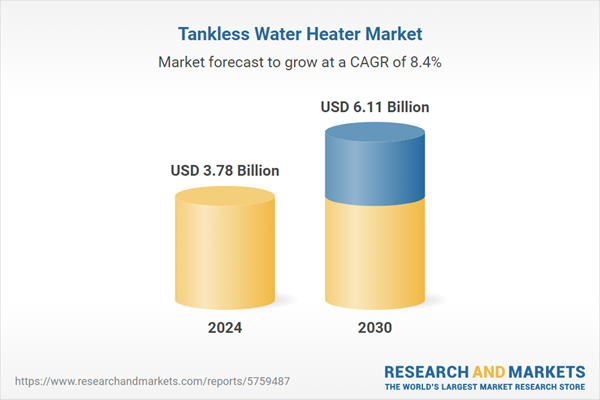Speak directly to the analyst to clarify any post sales queries you may have.
10% Free customizationThis report comes with 10% free customization, enabling you to add data that meets your specific business needs.
Their compact design makes them ideal for urban homes, apartments, and commercial spaces with limited space. Technological advancements, such as smart controls and improved heating efficiency, are further enhancing their appeal. Additionally, growing environmental concerns and supportive government incentives promoting sustainable appliances are driving adoption. Rising disposable incomes and modern lifestyle trends are also contributing to the market’s expansion worldwide
Key Market Drivers
Rising Demand for Energy-Efficient Water Heating Solutions
A key driver of growth in the global tankless water heater market is the increasing focus on energy efficiency. Unlike traditional storage water heaters, which constantly heat large volumes of water and incur significant standby energy losses, tankless models operate only when hot water is needed. This on-demand functionality greatly reduces energy wastage and lowers utility costs, making them attractive to both residential and commercial users seeking to reduce carbon footprints and operational expenses. The shift is reinforced by rising environmental awareness and stricter energy efficiency regulations. Many governments now implement efficiency labeling programs and offer tax incentives or rebates to encourage the adoption of eco-friendly appliances. Strengthening this trend, the U.S. Department of Energy, in December 2024, introduced updated efficiency standards for gas-fired instantaneous (tankless) water heaters, mandating roughly 13% higher energy efficiency effectively requiring condensing technology to boost performance and align with long-term sustainability goals.Key Market Challenges
High Initial Purchase and Installation Costs
One of the most significant challenges hindering the widespread adoption of tankless water heaters is their relatively high upfront cost. Compared to traditional storage water heaters, tankless systems can cost significantly more to purchase and install. The installation process is often more complex, requiring specialized labor, additional plumbing adjustments, and in many cases, electrical or gas line upgrades to meet the unit’s operational requirements. For example, high-capacity tankless models may need enhanced venting systems or increased electrical capacity, adding to the total expense.While the long-term operational savings and extended lifespan of tankless units can offset the initial investment, many consumers, particularly in price-sensitive markets, hesitate to switch from conventional systems. This cost barrier is particularly pronounced in developing regions, where consumers prioritize affordability over long-term efficiency benefits. Even in developed markets, some homeowners delay adoption due to the perception that the payback period is too long, despite potential energy savings.
Key Market Trends
Integration of Smart Technology and IoT Connectivity
The integration of smart technology into tankless water heaters is becoming a defining trend in the market. Manufacturers are increasingly equipping units with Wi-Fi connectivity, smartphone compatibility, and advanced digital control panels. These features allow users to remotely monitor water temperature, adjust heating settings, and track energy consumption in real time through mobile apps.Many modern models also include voice control compatibility with popular smart home assistants, enabling hands-free operation. IoT-enabled diagnostics can detect issues early and send alerts for maintenance, reducing downtime and repair costs. This shift toward smart integration not only enhances user convenience but also aligns with the broader global trend of connected, energy-efficient home appliances. In addition, the ability to integrate with home energy management systems allows for automated scheduling of water heating during off-peak electricity hours, maximizing cost savings and reducing grid strain.
Key Market Players
- Ariston Holding N.V.
- A.O. Smith
- Bosch Thermotechnology Corp
- Bradford White Corporation
- GE Appliances
- Rheem Manufacturing Company
- Whirlpool Corporation
- Rinnai Corporation
- Ferroli S.p.A
- Havells India Limited
Report Scope:
In this report, the Global Tankless Water Heater Market has been segmented into the following categories, in addition to the industry trends which have also been detailed below:Tankless Water Heater Market, By Technology:
- Condensing
- Non-Condensing
Tankless Water Heater Market, By Energy Source:
- Electric
- Gas
Tankless Water Heater Market, By End Use:
- Condominium
- Salon/Parlor
- Hotels & Resort
- Hospitals
- Residential
- Others
Tankless Water Heater Market, By Sales Channel:
- Hypermarkets/Supermarkets
- Exclusive Stores
- Multi-brand Stores
- Online
- Others
Tankless Water Heater Market, By Region:
- North America
- United States
- Canada
- Mexico
- Europe
- France
- United Kingdom
- Italy
- Germany
- Spain
- Asia-Pacific
- China
- Japan
- India
- South Korea
- Indonesia
- South America
- Argentina
- Colombia
- Brazil
- Middle East & Africa
- South Africa
- Saudi Arabia
- UAE
- Turkey
Competitive Landscape
Company Profiles: Detailed analysis of the major companies present in the Global Tankless Water Heater Market.Available Customizations:
With the given market data, the publisher offers customizations according to a company's specific needs. The following customization options are available for the report.Company Information
- Detailed analysis and profiling of additional market players (up to five).
This product will be delivered within 1-3 business days.
Table of Contents
Companies Mentioned
- Ariston Holding N.V.
- A.O. Smith
- Bosch Thermotechnology Corp
- Bradford White Corporation
- GE Appliances
- Rheem Manufacturing Company
- Whirlpool Corporation
- Rinnai Corporation
- Ferroli S.p.A
- Havells India Limited
Table Information
| Report Attribute | Details |
|---|---|
| No. of Pages | 181 |
| Published | September 2025 |
| Forecast Period | 2024 - 2030 |
| Estimated Market Value ( USD | $ 3.78 Billion |
| Forecasted Market Value ( USD | $ 6.11 Billion |
| Compound Annual Growth Rate | 8.3% |
| Regions Covered | Global |
| No. of Companies Mentioned | 10 |









